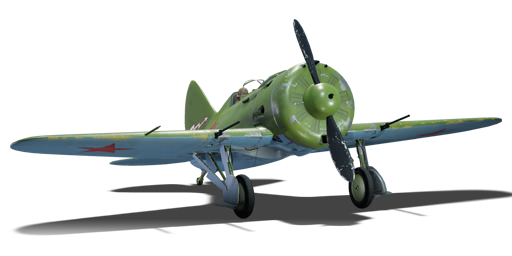



The I-16 was developed in the same time as its biplane contemporary I-15 also made by Polikarpov. It was the first low-wing cantilever monoplane fighter with retractable gear to reach operational status. The I-16 boasted superior manoeuvrability as well as speed compared to contemporary biplanes such as the He 51 or C.R.32 as was proven during the Spanish Civil War, however with the entry of the Condor Legion, the I-16s were outclassed by Bf 109s. The I-16 type 27 was based on the type 17 but used an M-62 engine instead of the M-25V engine. Otherwise, it was similar to the type 17, featuring the two ShKAS machine guns in the nose and two ShVAK cannons in wings, and rubber tail wheel instead of skid. I-16s served in the Spanish Republican air force, Soviet air force and Chinese Nationalist air force.
The I-16 type 27 was introduced in Update 1.39. It is one the final developments of the I-16, and it has the best set of weapons and ordnance available compared to the rest of the I-16s. The I-16 is very good for horizontal turnfighting being better than nearly all but few planes such as the A6M series or Spitfires. The I-16 is quite heavily armed for a plane its size and is a formidable opponent. However, the I-16 struggles to catch the majority of its opponents as well as having low dive speed compared to contemporaries.
flaps
flaps
flaps
brake
| Belt | Belt filling | Armor penetration (mm) at a distance: | |||||
|---|---|---|---|---|---|---|---|
| 10 m | 100 m | 500 m | 1000 m | 1500 m | 2000 m | ||
| T/HEF-I | 10 | 8 | 7 | 6 | 0 | 0 | |
| T/HEF-I/T/T | 10 | 8 | 7 | 6 | 0 | 0 | |
| HEF/HEF-I/HEF/T | 10 | 8 | 7 | 6 | 0 | 0 | |
| HEF | 3 | 3 | 3 | 3 | 3 | 3 | |
| Belt | Belt filling | Armor penetration (mm) at a distance: | |||||
|---|---|---|---|---|---|---|---|
| 10 m | 100 m | 500 m | 1000 m | 1500 m | 2000 m | ||
| T/Ball/Ball/AP-I/AI | 13 | 12 | 7 | 3 | 2 | 0 | |
| AP-I/AI/API-T | 13 | 12 | 7 | 3 | 2 | 0 | |
| AP-I/API-T | 13 | 12 | 7 | 3 | 2 | 0 | |
| AP-I/AP-I/AP-I/AI | 13 | 12 | 7 | 3 | 2 | 0 | |












Flight performance | |
|---|---|
Survivability |
|---|
Weaponry | |
|---|---|